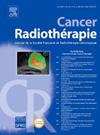立体定向体放射治疗后肺部放射学变化分析
IF 1.4
4区 医学
Q4 ONCOLOGY
引用次数: 0
摘要
目的:立体定向放射治疗适用于早期不能手术的肺癌和手术排斥,也是少转移、复发和/或复发肿瘤的一种选择。本研究的目的是分析CT扫描中不同类型放射学改变的发生率,将其发生与危险因素联系起来,并分析成像信息在预测局部无进展生存期方面的治疗结果的有用性。材料与方法回顾性分析2014年至2022年接受肺立体定向放射治疗的104例患者的资料。治疗后一个月进行了第一次检查。然后在第一年每3至4个月进行一次访问,并进行影像学检查(CT或PET),第一年之后每4至6个月进行一次访问。急性放射学改变定义为前6个月发生的变化,慢性放射学改变定义为治疗后6个月开始发生的变化。结果44.44%的患者表现为急性影像学改变,其中高达86%的患者表现为慢性。改良的常规纤维化模式最为普遍。接受肺胸部放射治疗和外周肿瘤的照射显著增加出现慢性放射学改变的可能性。15名患者在出现慢性变化后接受了进一步的检查,如PET扫描,以怀疑局部进展,其中11名患者呈阳性。没有发现急性或慢性放射学改变的发生与生存恶化或局部进展百分比较高之间的关联。结论正确了解肺立体定向放射治疗继发的不同类型的放射学改变及其随时间的动态变化对于区分良性病理和进展是必要的。本文章由计算机程序翻译,如有差异,请以英文原文为准。
Analysis of radiological lung changes after stereotactic body radiation therapy
Purpose
Stereotactic body radiation therapy is indicated in cases of early inoperable lung cancer and surgical rejection, and it is also an option for oligometastatic, recurrent, and/or relapsing tumours. The aim of this study was to analyse the incidence of different patterns of radiological changes on CT scans, correlate their occurrence with risk factors, and analyse the usefulness of imaging information to predict treatment outcome in terms of local progression-free survival.
Materials and methods
A retrospective review was carried out on the data from 104 patients who received lung stereotactic body radiation therapy between 2014 and 2022. A first check-up visit was carried out a month after treatment. Visits were then performed every 3 to 4 months during the first year, with imaging tests (CT or PET), and every 4 to 6 months after the first year. Acute radiological changes were defined as those occurring in the first 6 months and chronic radiological changes as those occurring starting from 6 months onwards following treatment.
Results
Acute radiological changes were detected in 44.44 % of the patients, with up to 86 % of them appearing chronically. The modified conventional fibrosis pattern was the most prevalent. Having received lung thoracic radiotherapy and irradiation of tumours located in peripheral regions significantly increases the likelihood of chronic radiological changes appearing. Fifteen patients underwent further tests such as a PET scan for suspected local progression after the appearance of chronic changes, of which 11 were positive. No association was identified between the occurrence of either acute or chronic radiological changes with worsened survival or a higher percentage of local progression.
Conclusions
Proper knowledge of the different patterns of radiological changes secondary to lung stereotactic body radiation therapy and their dynamics over time is necessary to discern between a benign pathology and progression.
求助全文
通过发布文献求助,成功后即可免费获取论文全文。
去求助
来源期刊

Cancer Radiotherapie
医学-核医学
CiteScore
2.20
自引率
23.10%
发文量
129
审稿时长
63 days
期刊介绍:
Cancer/radiothérapie se veut d''abord et avant tout un organe francophone de publication des travaux de recherche en radiothérapie. La revue a pour objectif de diffuser les informations majeures sur les travaux de recherche en cancérologie et tout ce qui touche de près ou de loin au traitement du cancer par les radiations : technologie, radiophysique, radiobiologie et radiothérapie clinique.
 求助内容:
求助内容: 应助结果提醒方式:
应助结果提醒方式:


